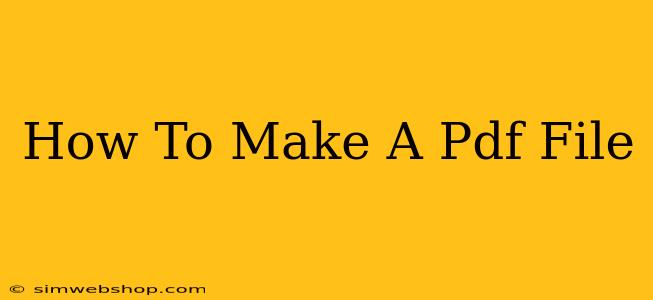Creating PDF files is a crucial skill in today's digital world. Whether you need to share a document, preserve formatting, or ensure compatibility across different devices, knowing how to generate PDFs is essential. This guide will walk you through various methods, catering to different software and skill levels.
Method 1: Using Microsoft Word
Microsoft Word, a widely used word processor, offers a straightforward way to create PDFs.
Steps:
- Open your Word document: Launch Microsoft Word and open the document you wish to convert to a PDF.
- Click "File": Navigate to the "File" tab in the top left corner of the screen.
- Select "Export": In the left-hand menu, click on "Export."
- Choose "Create PDF/XPS": Select this option from the list of export formats.
- Save your PDF: A new window will appear. Choose a location to save your file and give it a name. Click "Publish" to create the PDF.
Pro Tip: Before saving, review the "Options" button to ensure the PDF settings are optimal for your needs (e.g., size optimization for email sharing).
Method 2: Using Google Docs
For those who prefer cloud-based solutions, Google Docs provides a seamless PDF creation process.
Steps:
- Open your Google Doc: Access your document through your Google Drive.
- Click "File": Locate the "File" menu in the top left corner.
- Select "Download": From the dropdown menu, choose "Download."
- Choose "PDF document (.pdf)": Select this option to download your document as a PDF.
This method is incredibly convenient for collaboration and online sharing, as it directly leverages Google Drive's capabilities.
Method 3: Using a PDF Creator Tool (e.g., Adobe Acrobat, PDFelement)
Dedicated PDF creator tools offer more advanced features and control over the final PDF output. While some are free, others may require a subscription or one-time purchase.
Features to Consider:
- Security: Encrypting your PDF to protect sensitive information.
- Editing: The ability to edit existing PDFs.
- Compression: Reducing file size for easier sharing and storage.
- Conversion: Converting other file types (like images) into PDFs.
These tools often provide a more streamlined and professional PDF creation experience. Explore free trials or demos to find the best fit for your needs.
Method 4: Taking a Screenshot and Converting to PDF
For quick and simple conversions of single pages (like web pages or images), a screenshot followed by conversion is a viable option.
Steps:
- Take a screenshot: Use your operating system's screenshot functionality (e.g., Print Screen key).
- Save the image: Save the screenshot as an image file (e.g., PNG, JPG).
- Use an online converter: Numerous free online tools convert images to PDFs. Simply upload your image and download the converted PDF.
Important Note: This method is best suited for single-page documents. Multi-page documents require more sophisticated methods.
Choosing the Right Method
The best method for creating a PDF depends on your specific requirements:
- For simple documents from Word: Use the built-in Word functionality.
- For collaborative documents: Utilize Google Docs' seamless integration.
- For advanced features and control: Invest in a dedicated PDF creator tool.
- For quick single-page conversions: Employ the screenshot and conversion method.
By mastering these techniques, you’ll efficiently create PDFs for various purposes, enhancing productivity and streamlining your workflow. Remember to always save a backup of your original files before conversion.

